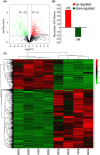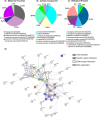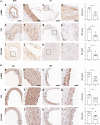Comparative bioinformatics analysis between proteomes of rabbit aneurysm model and human intracranial aneurysm with label-free quantitative proteomics
- PMID: 33389819
- PMCID: PMC7804895
- DOI: 10.1111/cns.13570
Comparative bioinformatics analysis between proteomes of rabbit aneurysm model and human intracranial aneurysm with label-free quantitative proteomics
Abstract
Aims: This study aimed to find critical proteins involved in the development of intracranial aneurysm by comparing proteomes of rabbit aneurysm model and human aneurysms.
Methods: Five human intracranial aneurysm samples and 5 superficial temporal artery samples, and 4 rabbit aneurysm samples and 4 control samples were collected for protein mass spectrometry. Four human intracranial aneurysm samples and 4 superficial temporal artery samples, and 6 rabbit aneurysm samples and 6 control samples were used for immunochemistry.
Results: Proteomic analysis revealed 180 significantly differentially expressed proteins in human intracranial aneurysms and 716 significantly differentially expressed proteins in rabbit aneurysms. Among them, 57 proteins were differentially expressed in both species, in which 24 were increased and 33 were decreased in aneurysms compared to the control groups. Proteins were involved in focal adhesion and extracellular matrix-receptor interaction pathways. We found that COL4A2, MYLK, VCL, and TAGLN may be related to aneurysm development.
Conclusion: Proteomics analysis provided fundamental insights into the pathogenesis of aneurysm. Proteins related to focal adhesion and extracellular matrix-receptor interaction pathways play an important role in the occurrence and development of intracranial aneurysm.
Keywords: bioinformatics; focal adhesion; intracranial aneurysm; proteomics; rabbit elastase-induced aneurysm.
© 2021 The Authors. CNS Neuroscience & Therapeutics Published by John Wiley & Sons Ltd.
Conflict of interest statement
The authors declare that they have no competing interests.
Figures






Similar articles
-
Comparative proteome analysis of saccular intracranial aneurysms with iTRAQ quantitative proteomics.J Proteomics. 2016 Jan 1;130:120-8. doi: 10.1016/j.jprot.2015.09.014. Epub 2015 Sep 15. J Proteomics. 2016. PMID: 26385002
-
Quantitative proteomics analysis of differentially expressed proteins in ruptured and unruptured cerebral aneurysms by iTRAQ.J Proteomics. 2018 Jun 30;182:45-52. doi: 10.1016/j.jprot.2018.05.001. Epub 2018 May 3. J Proteomics. 2018. PMID: 29729990
-
mRNA expression in rabbit experimental aneurysms: a study using gene chip microarrays.AJNR Am J Neuroradiol. 2007 May;28(5):864-9. AJNR Am J Neuroradiol. 2007. PMID: 17494658 Free PMC article.
-
The development and understanding of intracranial aneurysm based on rabbit model.Neuroradiology. 2020 Oct;62(10):1219-1230. doi: 10.1007/s00234-020-02475-z. Epub 2020 Jun 27. Neuroradiology. 2020. PMID: 32594185 Review.
-
Functional annotation and biological interpretation of proteomics data.Biochim Biophys Acta. 2015 Jan;1854(1):46-54. doi: 10.1016/j.bbapap.2014.10.019. Epub 2014 Oct 31. Biochim Biophys Acta. 2015. PMID: 25448015 Review.
Cited by
-
Clinical Usage of Different Doses of Cis-Atracurium in Intracranial Aneurysm Surgery and Its Effect on Motor-Evoked Potentials.Comput Math Methods Med. 2022 Jun 28;2022:5910019. doi: 10.1155/2022/5910019. eCollection 2022. Comput Math Methods Med. 2022. PMID: 35799657 Free PMC article.
-
Bioinformatics analysis revealed the potential crosstalk genes and molecular mechanisms between intracranial aneurysms and periodontitis.BMC Med Genomics. 2024 Apr 29;17(1):114. doi: 10.1186/s12920-024-01864-0. BMC Med Genomics. 2024. PMID: 38685029 Free PMC article.
-
Early vascular embolization improves neurological function in patients with intracranial aneurysm.Am J Transl Res. 2024 Apr 15;16(4):1273-1280. doi: 10.62347/ISIS6489. eCollection 2024. Am J Transl Res. 2024. PMID: 38715829 Free PMC article.
-
Predicting early functional outcomes in aneurysmal subarachnoid hemorrhage in endovascular coiling and surgical clipping.Front Neurol. 2025 May 7;16:1466188. doi: 10.3389/fneur.2025.1466188. eCollection 2025. Front Neurol. 2025. PMID: 40401030 Free PMC article.
-
Pharmacological inhibition of epidermal growth factor receptor attenuates intracranial aneurysm formation by modulating the phenotype of vascular smooth muscle cells.CNS Neurosci Ther. 2022 Jan;28(1):64-76. doi: 10.1111/cns.13735. Epub 2021 Nov 2. CNS Neurosci Ther. 2022. PMID: 34729926 Free PMC article.
References
-
- Etminan N, Rinkel GJ. Unruptured intracranial aneurysms: development, rupture and preventive management. Nat Rev Neurol. 2016;12(12):699‐713. - PubMed
-
- Juvela S, Poussa K, Lehto H, Porras M. Natural history of unruptured intracranial aneurysms: a long‐term follow‐up study. Stroke. 2013;44(9):2414‐2421. - PubMed
Publication types
MeSH terms
Substances
LinkOut - more resources
Full Text Sources
Other Literature Sources
Medical
Research Materials
Miscellaneous

